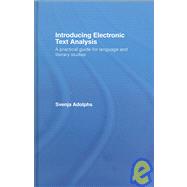
Note: Supplemental materials are not guaranteed with Rental or Used book purchases.
Purchase Benefits
Looking to rent a book? Rent Introducing Electronic Text Analysis: A Practical Guide for Language and Literary Studies [ISBN: 9780415320221] for the semester, quarter, and short term or search our site for other textbooks by Adolphs; Svenja. Renting a textbook can save you up to 90% from the cost of buying.
| List of tables and illustrations | viii | ||||
| Preface | x | ||||
| Acknowledgements | xii | ||||
| 1 Introduction | 1 | (15) | |||
|
1 | (3) | |||
|
4 | (2) | |||
|
6 | (1) | |||
|
7 | (2) | |||
|
9 | (2) | |||
|
11 | (2) | |||
|
13 | (1) | |||
|
14 | (1) | |||
|
15 | (1) | |||
| 2 Electronic text resources | 16 | (21) | |||
|
16 | (1) | |||
|
17 | (4) | |||
|
21 | (7) | |||
|
28 | (6) | |||
|
34 | (1) | |||
|
34 | (1) | |||
|
35 | (1) | |||
|
35 | (2) | |||
| 3 Exploring frequencies in texts: basic techniques | 37 | (14) | |||
|
37 | (1) | |||
|
38 | (1) | |||
|
39 | (1) | |||
|
40 | (4) | |||
|
44 | (4) | |||
|
48 | (1) | |||
|
48 | (1) | |||
|
49 | (1) | |||
|
49 | (1) | |||
|
49 | (2) | |||
| 4 Exploring words and phrases in use: basic techniques | 51 | (13) | |||
|
51 | (1) | |||
|
52 | (4) | |||
|
56 | (2) | |||
|
58 | (4) | |||
|
62 | (1) | |||
|
63 | (1) | |||
| 5 The electronic analysis of literary texts | 64 | (16) | |||
|
64 | (1) | |||
|
65 | (4) | |||
|
69 | (7) | |||
|
76 | (1) | |||
|
77 | (1) | |||
|
78 | (1) | |||
|
78 | (1) | |||
|
79 | (1) | |||
| 6 Electronic text analysis, language and ideology | 80 | (17) | |||
|
80 | (1) | |||
|
80 | (1) | |||
|
81 | (2) | |||
|
83 | (1) | |||
|
84 | (9) | |||
|
93 | (1) | |||
|
94 | (1) | |||
|
95 | (1) | |||
|
96 | (1) | |||
| 7 Language teaching applications | 97 | (20) | |||
|
97 | (1) | |||
|
98 | (1) | |||
|
99 | (6) | |||
|
105 | (4) | |||
|
109 | (1) | |||
|
110 | (2) | |||
|
112 | (1) | |||
|
113 | (2) | |||
|
115 | (1) | |||
|
116 | (1) | |||
| 8 Further fields of application | 117 | (17) | |||
|
117 | (1) | |||
|
117 | (1) | |||
|
118 | (11) | |||
|
129 | (1) | |||
|
130 | (1) | |||
|
131 | (1) | |||
|
132 | (1) | |||
|
132 | (2) | |||
| Appendix 1: Transcription conventions and codes in the CANCODE data | 134 | (2) | |||
| Glossary | 136 | (5) | |||
| Bibliography of websites | 141 | (5) | |||
| Bibliography | 146 | (9) | |||
| Index | 155 |
The New copy of this book will include any supplemental materials advertised. Please check the title of the book to determine if it should include any access cards, study guides, lab manuals, CDs, etc.
The Used, Rental and eBook copies of this book are not guaranteed to include any supplemental materials. Typically, only the book itself is included. This is true even if the title states it includes any access cards, study guides, lab manuals, CDs, etc.